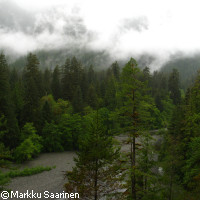Older forests are important carbon sinks, research reveals
Old-growth forests are important global carbon sinks and should be recognised as such under the Kyoto Protocol, according to new EU-funded research published in the journal Nature. The international team of scientists found that old-growth forests in the northern hemisphere are responsible for up to 10% of the global net uptake of carbon dioxide (CO2). The discovery challenges the commonly held belief that these older woodlands are effectively carbon neutral. That belief stems from a 1960s study by American scientist Eugene Odum, which appeared to show that forests over 150 years old release as much CO2 into the atmosphere as they absorb, rendering them carbon neutral overall. Although that study drew on just 10 years of data from a single plantation, it soon became accepted wisdom on the subject. 'That's the story that we all learned for decades in ecology classes. But it was just based on observations in a single study of one type of forest, and it simply doesn't apply in all cases,' commented Professor Beverly Law of Oregon State University in the US, one of the authors of the study. In this latest piece of research, scientists from Belgium, France, Germany, the UK, Switzerland and the US studied data from 519 old-growth forest sites. They found that far from being carbon neutral, the majority of forests between 15 and 800 years old are carbon sinks, absorbing more carbon than they release. Old-growth forests in the northern hemisphere account for 15% of the world's total forested area. The scientists calculate that these ancient woodlands alone soak up around 1.3 gigatonnes of carbon per year, equivalent to 10% of the net global uptake of CO2. The Kyoto Protocol covers afforestation, reforestation and deforestation activities, in its calculations of carbon budgets. However, simply leaving forests intact is not considered to be a human activity. Nevertheless, the new data makes it clear that ancient forests are in fact important carbon sinks. Furthermore, if these forests are disturbed, their vast reserves of carbon will be released back into the atmosphere. 'Because old-growth forests steadily accumulate carbon for centuries, they contain vast quantities of it,' the researchers conclude. 'They will lose much of this carbon to the atmosphere if they are disturbed, so carbon-accounting rules for forests should give credit for leaving old-growth forest intact.' The findings have important implications for countries with large stands of old- growth forest; they may now find it easier to offset greenhouse gas emissions by leaving their forests intact. 'If you are concerned about offsetting greenhouse gas emissions and look at old forests from nothing more than a carbon perspective, the best thing to do is leave them alone,' stated Professor Law. Furthermore, computer simulations of climate change will need to be modified to take into account the new-found role of old-growth forests in the global carbon cycle. EU support for the study came form the CarboEurope ('Assessment of the European terrestrial carbon balance') project, which is financed through the 'Sustainable development, global change and ecosystems' Thematic area of the Sixth Framework Programme (FP6).



